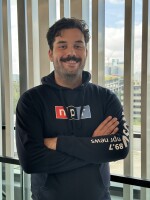Columbus City Council will vote Monday on whether or not to spend $94,000 to hire an expert to help train Columbus police officers on how to have dialogue with rowdy sports and protest crowds.
The city will decide whether or not to hire Professor Clifford Stott, a social psychology professor in England with Keele University. Stott has written extensively on how police respond to sports riots and hooliganism at European soccer games.
Columbus wants to hire Stott to work with The Ohio State University and the Columbus Division of Police Dialogue Unit that was launched in October. Stott's work has already helped the unit inform their practices since being formed last year.
If the council votes to hire Conflict Management LTD., Stott's firm, it will kick off the first phase of the city's ENABLE Columbus program in partnership with Keele University and Ohio State University. The program aims "to develop research expertise and enhance crowd management strategies, foster dialogue between police and demonstrators and safeguard First Amendment rights," according to the city council agenda.
Stott will primarily work with the Columbus Division of Police Dialogue Unit. The unit officers, under CPD Commander Duane Mabry, are clad in light blue vests over their typical uniform and can be seen at various protests and demonstrations throughout the city.
The unit officially formed a year ago to work during Stonewall Columbus Pride, but the department has been working since 2014 to improve how its responded to protests.
Mabry said police departments have evolved how to respond to crowds and protests for years ever since Ohio National Guard was deployed to Kent State University in 1984 and killed four student protestors.
Stott's research focuses heavily on how police in Europe respond to rowdy crowds at European soccer games, but the city's police force has faced criticism for more than just its response to rowdy sports crowds.
Ohio State football fans rioted as recently as 2015 when the Buckeyes beat Oregon in the National Championship. Fans burned couches and were tear gassed by police.
More recently Columbus Police faced criticism when they used tear gas, pepper spray and rubber and wooden bullets against racial justice protesters in 2020.
Mabry said 2020 caused another shift in how police think about how they respond to crowds. He said this work with Stott could become a model for other cities.
"That model is us engaging and facilitating First Amendment activity," Mabry said. "So we try to engage as much as possible with groups who want to protest and try to facilitate that protest to have their voice... and they can air their grievances. And so that's that's a huge change."
Mabry said the unit responds to all types of protests from the near-daily ones that occur at the Ohio Statehouse to more tense ones where police are alert for potential escalations.
Columbus police monitored a protest in April where a group of neo-Nazis protested in front of Land Grant Brewing Company during a drag queen brunch.
The Columbus Dispatch wrote that the protesters, dressed in red, appear to have worn black ski masks to cover their faces. A few dozen protesters carried a black flag with a swastika and a banner with the words "there will be blood." They chanted sayings including "no transgenders on our streets" and something with the phrase "under the Aryan sun."
Mabry said events like this illustrate the line the dialogue unit needs to walk when monitoring these events.
"Whether you agree with the Nazis point of view or not, the fact that the Nazi has a right to stay out there and say what they want to say is part of the process that is successful for everybody. Same for the drag queen," he said.
He compared police to the country of Switzerland and its historic neutrality in international conflict and said the police has to remain completely message neutral when it comes to people expressing their First Amendment rights.
"[CPD] can't choose a side, no matter how much you may agree with it or disagree with it, no matter how ugly it is or how beautiful it is not our job to to side with anyone," Mabry said.
The department's work with Stott has also brought them to Europe when Stott invited Mabry and others from CPD. They spent 21 days going to the United Kingdom and Switzerland.
Mabry said they were supposed to visit Ukraine but that visit was put on hold a week before Russia invaded the country.
"We still met with them online, our Ukraine counterparts. We met with the Swedes and the Spaniards and the European Union who are all trying to show how this science works in a democratic society," Mabry said.
Columbus City Council's agenda said this program will aim to make the city a best practice model for research-based policing of crowd events.
"We're setting the standard, that's good for everybody who lives here. That means we're really striving to be the department that the city is expected us to be. And they've been very vocal about us being in the last three years," Mabry said.
Mabry said CPD wants departments across the U.S. to look at Columbus and see what they can learn from it.
If the model is successful, the city said it could export this model to other locations in the U.S.




